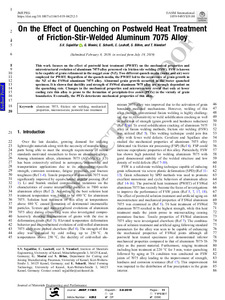On the Effect of Quenching on Postweld Heat Treatment of Friction-Stir-Welded Aluminum 7075 Alloy
| dc.date.accessioned | 2023-12-22T09:41:26Z | |
| dc.date.available | 2023-12-22T09:41:26Z | |
| dc.date.issued | 2019 | |
| dc.identifier | doi:10.17170/kobra-202312229269 | |
| dc.identifier.uri | http://hdl.handle.net/123456789/15318 | |
| dc.description | This version of the article has been accepted for publication, after peer review (when applicable) and is subject to Springer Nature’s AM terms of use, but is not the Version of Record and does not reflect post-acceptance improvements, or any corrections. | eng |
| dc.language.iso | eng | |
| dc.rights | Urheberrechtlich geschützt | |
| dc.rights.uri | https://rightsstatements.org/page/InC/1.0/ | |
| dc.subject | aluminum 7075 | eng |
| dc.subject | friction stir welding | eng |
| dc.subject | mechanical properties | eng |
| dc.subject | microstructure | eng |
| dc.subject | postweld heat treatment | eng |
| dc.subject.ddc | 600 | |
| dc.subject.ddc | 620 | |
| dc.title | On the Effect of Quenching on Postweld Heat Treatment of Friction-Stir-Welded Aluminum 7075 Alloy | eng |
| dc.type | Aufsatz | |
| dcterms.abstract | This work focuses on the effect of postweld heat treatment (PWHT) on the mechanical properties and microstructural evolution of aluminum 7075 alloy processed via friction stir welding (FSW). FSW is known to be capable of grain refinement in the nugget zone (NZ). Two different quench media (water and air) were employed for PWHT. Regardless of the quench media, the PWHT led to the occurrence of grain growth in the NZ of the FSWed aluminum 7075 alloy. Abnormal grain growth occurred in the water quenched specimen. It is shown that ductility and strength of FSWed aluminum 7075 alloy are strongly dependent on the quenching rate. Changes in the mechanical properties and microstructure reveal that only at lower cooling rate this alloy is prone to the formation of precipitate-free zones (PFZs) in the vicinity of grain boundaries. Eventually, the PFZs deteriorate mechanical properties of this alloy. | eng |
| dcterms.accessRights | open access | |
| dcterms.creator | Sajadifar, Seyed Vahid | |
| dcterms.creator | Moeini, Ghazal | |
| dcterms.creator | Scharifi, Emad | |
| dcterms.creator | Lauhoff, Christian | |
| dcterms.creator | Böhm, Stefan | |
| dcterms.creator | Niendorf, Thomas | |
| dc.relation.doi | doi:10.1007/s11665-019-04252-3 | |
| dc.subject.swd | Aluminiumlegierung | ger |
| dc.subject.swd | Rührreibschweißen | ger |
| dc.subject.swd | Mechanische Eigenschaft | ger |
| dc.subject.swd | Mikrostruktur | ger |
| dc.subject.swd | Quenching | ger |
| dc.subject.swd | Wärmebehandlung | ger |
| dc.type.version | acceptedVersion | |
| dcterms.source.identifier | eissn:1544-1024 | |
| dcterms.source.issue | Issue 8 | |
| dcterms.source.journal | The Journal of Materials Engineering and Performance | eng |
| dcterms.source.pageinfo | 5255-5265 | |
| dcterms.source.volume | Volume 28 | |
| kup.iskup | false |
Dateien zu dieser Ressource
Das Dokument erscheint in:
-
Publikationen [75]

